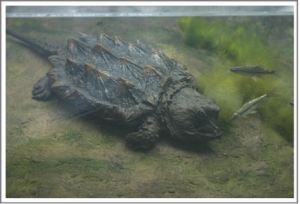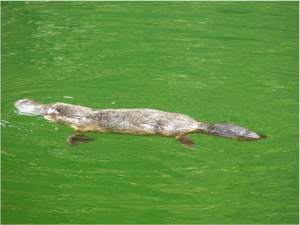Some of the animals alive today have not changed much since prehistoric times. Prehistoric means a very very long time ago!! While the dinosaurs went extinct, some creatures survived and they give us a picture into the past. Come with me, Jungle Jim to meet some of today’s ancient animals!
Horseshoe Crab
Horseshoe crabs are marine or ocean animals that live near the shore. The oldest horseshoe crab fossils date back to 450 million years ago. They are more closely related to spiders than other crabs. They have a sharp, pointy tail that looks dangerous, but it is only used to flip themselves when they get turned upside down. They may look intimidating, but horseshoe crabs are harmless to humans. The crabs and their eggs are important food for birds that live on the shore or migrate along the coast.
Lamprey
There are many different lamprey species and the oldest lamprey fossil is from 360 million years ago. This fossil looks very similar to lampreys that exist today. Lampreys have unusual looking mouths. They do not have a jaw, unlike many other creatures. Instead their mouth is in the shape of a circle. Some lampreys have many teeth in their circular mouth. Lampreys are long and skinny and look very similar to eels.
Alligator Snapping Turtle
 The alligator snapping turtle is the largest turtle in North America. These turtles can weigh up to 400 pounds! They have a thick, spiked shell, their mouths are shaped like a beak and their tails are scaly. This turtle resembles ancient dinosaurs. Its earliest fossils date back about 70 million years. While the fossil turtles are very old, turtles that are alive today can live a really long time. Some of the oldest alligator snapping turtles live to be 100 years old.
The alligator snapping turtle is the largest turtle in North America. These turtles can weigh up to 400 pounds! They have a thick, spiked shell, their mouths are shaped like a beak and their tails are scaly. This turtle resembles ancient dinosaurs. Its earliest fossils date back about 70 million years. While the fossil turtles are very old, turtles that are alive today can live a really long time. Some of the oldest alligator snapping turtles live to be 100 years old.
Platypus
 Platypuses are a strange mashup of many creatures. They have a body with soft fur like an otter, a tail like a beaver and a bill like a duck. They also have webbed feet similar to a duck to help them swim. Platypuses live only in a small area of Australia and Tasmania. Ancient platypuses were bigger than the ones that live today, but they are otherwise very similar. Platypuses can excrete venom or poison through a spur on their back feet. Very few other mammals use venom for protection. It is not deadly to humans, but it can be very painful. Platypuses are at their best in the water. They move much faster and have the ability to hunt for food even in dark, murky water.
Platypuses are a strange mashup of many creatures. They have a body with soft fur like an otter, a tail like a beaver and a bill like a duck. They also have webbed feet similar to a duck to help them swim. Platypuses live only in a small area of Australia and Tasmania. Ancient platypuses were bigger than the ones that live today, but they are otherwise very similar. Platypuses can excrete venom or poison through a spur on their back feet. Very few other mammals use venom for protection. It is not deadly to humans, but it can be very painful. Platypuses are at their best in the water. They move much faster and have the ability to hunt for food even in dark, murky water.
Solenodon
Scientists thought the solenodon was extinct, but it was found again in Cuba in 2012. These little creatures have remained unchanged for millions of years. They are the size of a shrew, which is similar to a large mouse or small rat, and like the platypus they are a venomous mammal. They inject venom through their teeth. Unfortunately, it is not poisonous enough to stop large predators from eating them. ask women They do not move very fast, so solenodons are easily captured by cats and dogs. These little, ancient creatures are extremely rare and could easily become extinct without protection.
Living Fossils
These creatures are often called living fossils. Fossils are pieces of animals that have been preserved in rock. Living fossils show us what creatures looked like a long time ago and can help us understand how animals have changed throughout history and how they have stayed the same. Thanks for learning about these amazing and ancient creatures with me!
Sources
“Facts about Horseshoe Crabs” Florida Fish and Wildlife Conservation Commission.
“Fish Facts-Sea Lamprey” US Fish and Wildlife Service
